Diagnostic Evaluation and Preparation of the Reference Information for River Restoration in South Korea
Abstract
1. Introduction
2. Materials and Methods
2.1. Study Area
2.2. Data Sampling
2.3. Data Processing
2.4. Preparation of the Reference Information for Restoration of the Degraded River
2.5. Statistical Analysis
3. Results
3.1. Diagnostic Evaluation of Rivers
3.2. Relationships between the Riparian Vegetation Index and Grades Based on Each Vegetation Component
3.3. Relationships between the Riparian Vegetation Index and Indices Based on Other Taxa and Water Quality
3.4. Reference Information for Restoration of the Degraded River
3.5. Restoration Plan Based on the Diagnostic Evaluation Results
4. Discussion
4.1. Evolution of River Assessment Methods
4.2. Naturalness of the Rivers in Korea Based on Riparian Vegetation
4.3. Necessity of River Restoration
4.4. Recommendations for Achieving true Restoration
5. Conclusions
Author Contributions
Funding
Institutional Review Board Statement
Informed Consent Statement
Conflicts of Interest
References
- Sioli, H. Tropical rivers as expressions of their terrestrial environments. In Tropical Ecological Systems; Springer: Berlin, Germany, 1975; pp. 275–288. [Google Scholar]
- Shaker, R.; Ehlinger, T.J.; Smith, B.; Goodman, I. Agricultural Land Fragmentation and Biological Integrity: The Impacts of a Rapidly Changing Landscape on Streams in Southeastern Wisconsin; Fish Ecology Laboratory, University of Wisconsin-Milwaukee: Milwaukee, WI, USA, 2007. [Google Scholar]
- Karr, J.R.; Dudley, D.R. Ecological perspective on water quality goals. Environ. Manag. 1981, 5, 55–68. [Google Scholar] [CrossRef]
- Angermeier, P.L.; Karr, J.R. Biological integrity versus biological diversity as policy directives: Protecting biotic resources. In Ecosystem Management; Springer: New York, NY, USA, 1994; pp. 264–275. [Google Scholar]
- Karr, J.R. Ecological integrity and ecological health are not the same. In Engineering within Ecological Constraints; National Academy Press: Washington, DC, USA, 1996; pp. 97–109. [Google Scholar]
- Karr, J.R.; Chu, E.W. Biological monitoring and assessment: Using multimetric indexes effectively. Hum. Ecol. Risk Assess. 1997, 3, 993–1004. Available online: https://www.researchgate.net/profile/James_Karr/publication/245587748_Biological_Monitoring_and_Assessment_Using_Multimetric_Indexes_Effectively/links/55edbe5308ae199d47bdf5d4.pdf (accessed on 10 October 2020). [CrossRef]
- Karr, J.R. Ecological Integrity: An Essential Ingredient for Humans’ Long-Term Success. In Globalisation and Ecological Integrity in Science and International Law; Cambridge Scholars Publishing: Newcastle, UK, 2011; pp. 8–25. [Google Scholar]
- Rapport, D.J.; Regier, H.A.; Hutchinson, T. Ecosystem behavior under stress. Am. Nat. 1985, 125, 617–640. [Google Scholar] [CrossRef]
- Karr, J.R.; Fausch, K.D.; Angermeier, P.L.; Yant, P.R.; Schlosser, I.J. Assessing Biological Integrity in Running Waters: A Method and Its Rationale. Illinois Natural History Survey Special Publication 5, Champaign, IL, USA. 1986. Available online: https://semspub.epa.gov/work/01/554353.pdf (accessed on 20 October 2020).
- Parrish, J.D.; Braun, D.P.; Unnasch, R.S. Are we conserving what we say we are? Measuring ecological integrity within protected areas. BioScience 2003, 53, 851–860. [Google Scholar] [CrossRef]
- Morley, S.A.; Karr, J.R. Assessing and restoring the health of urban streams in the Puget Sound Basin. Conserv. Biol. 2002, 16, 1498–1509. [Google Scholar] [CrossRef]
- Wang, L.; Kanehl, P. Influences of watershed urbanization and instream habitat on macroinvertebrates in cold water streams 1. J. Am. Water Resour. Assoc. 2003, 39, 1181–1196. [Google Scholar] [CrossRef]
- Gregory, S.V.; Swanson, F.J.; McKee, W.A.; Cummins, K.W. An ecosystem perspective of riparian zones. BioScience 1991, 41, 540–551. [Google Scholar] [CrossRef]
- Dias-Silva, K.; Cabette, H.S.; Juen, L. The influence of habitat integrity and physical-chemical water variables on the structure of aquatic and semi-aquatic Heteroptera. Zoologia 2010, 27, 918–930. [Google Scholar] [CrossRef]
- del Tanago, M.G.; de Jalon, D.G. Riparian Quality Index (RQI): A methodology for characterising and assessing the environmental conditions of riparian zones. Limnetica 2011, 30, 235–254. [Google Scholar]
- Ward, J.V. The four-dimensional nature of lotic ecosystems. J. N. Am. Benthol. Soc. 1989, 8, 2–8. [Google Scholar] [CrossRef]
- Ward, J.V.; Malard, F.; Tockner, K. Landscape ecology: A framework for integrating pattern and process in river corridors. Landsc. Ecol. 2002, 17, 35–45. [Google Scholar] [CrossRef]
- Naiman, R.J.; Decamps, H.; McClain, M.E. Riparia: Ecology, Conservation, and Management of Streamside Communities; Elsevier Academic Press: London, UK, 2005. [Google Scholar]
- Corenblit, D.; Tabacchi, E.; Steiger, J.; Gurnell, A.M. Reciprocal interactions and adjustments between fluvial landforms and vegetation dynamics in river corridors: A review of complementary approaches. Earth-Sci. Rev. 2007, 84, 56–86. [Google Scholar] [CrossRef]
- Johnson, R.R.; Simpson, J.M. Important birds from Blue Point Cottonwoods, Maricopa County, Arizona. Condor 1971, 73, 379–380. [Google Scholar] [CrossRef]
- Carothers, S.W.; Roy Johnson, R.; Aitchison, S.W. Population structure and social organization of southwestern riparian birds. Am. Zool. 1974, 14, 97–108. [Google Scholar] [CrossRef]
- Santos, M.J.; Matos, H.M.; Palomares, F.; Santos-Reis, M. Factors affecting mammalian carnivore use of riparian ecosystems in Mediterranean climates. J. Mammal. 2011, 92, 1060–1069. [Google Scholar] [CrossRef]
- Hamilton, B.T.; Roeder, B.L.; Hatch, K.A.; Eggett, D.L.; Tingey, D. Why is small mammal diversity higher in riparian areas than in uplands? J. Arid Environ. 2015, 119, 41–50. [Google Scholar] [CrossRef]
- Howard-Williams, C.; Pickmere, S.; Davies, J. Nutrient retention and processing in New Zealand streams: The influence of riparian vegetation. N. Z. Agric. Sci. 1986, 20, 110–114. [Google Scholar]
- Cooke, J.G.; Cooper, A.B. Sources and sinks of nutrients in a New Zealand hill pasture catchment iii. Nitrogen. Hydrol. Process. 1988, 2, 135–149. [Google Scholar] [CrossRef]
- Pinay, G.; Decamps, H. The role of riparian woods in regulating nitrogen fluxes between the alluvial aquifer and surface water: A conceptual model. Regul. Rivers Res. Manag. 1988, 2, 507–516. [Google Scholar] [CrossRef]
- Haycock, N.; Burt, T. Handling excess nitrates. Nature 1990, 348, 291. [Google Scholar] [CrossRef]
- Fustec, E.; Mariotti, A.; Grillo, X.; Sajus, J. Nitrate removal by denitrification in alluvial ground water: Role of a former channel. J. Hydrol. 1991, 123, 337–354. [Google Scholar] [CrossRef]
- Haycock, N.E.; Burt, T.P. Role of floodplain sediments in reducing the nitrate concentration of subsurface run-off: A case study in the Cotswolds, UK. Hydrol. Process. 1993, 7, 287–295. [Google Scholar] [CrossRef]
- Salinas, M.J.; Guirado, J. Riparian plant restoration in summer-dry riverbeds of southeastern Spain. Restor. Ecol. 2002, 10, 695–702. [Google Scholar] [CrossRef]
- Horn, R.; Richards, J.S. Flow-vegetation interactions in restored floodplain environments. In Hydroecology and Ecohydrology: Past, Present and Future; John Wiley & Sons, Ltd: Chichester, UK, 2007; pp. 269–294. [Google Scholar]
- Roberts, M.L.; Bilby, R.E.; Booth, D.B. Hydraulic dispersion and reach-averaged velocity as indicators of enhanced organic matter transport in small Puget Lowland streams across an urban gradient. Fundam. Appl. Limnol. Arch. Hydrobiol. 2008, 171, 145–159. [Google Scholar] [CrossRef]
- Gurnell, A.M.; Petts, G.E. Island-dominated landscapes of large floodplain rivers, a European perspective. Freshw. Biol. 2002, 47, 581–600. [Google Scholar] [CrossRef]
- Gurnell, A.; Petts, G. Trees as riparian engineers: The Tagliamento River, Italy. Earth Surf. Process. Landforms 2006, 31, 1558–1574. [Google Scholar] [CrossRef]
- Corenblit, D.; Gurnell, A.M.; Steiger, J.; Tabacchi, E. Reciprocal adjustments between landforms and living organisms: Extended geomorphic evolutionary insights. Catena 2008, 73, 261–273. [Google Scholar] [CrossRef]
- Corenblit, D.; Steiger, J.; Gurnell, A.M.; Naiman, R.J. Plants intertwine fluvial landform dynamics with ecological succession and natural selection: A niche construction perspective for riparian systems. Global. Ecol. Biogeogr. 2009, 18, 507–520. [Google Scholar] [CrossRef]
- Tabacchi, E.; Lambs, L.; Guilloy, H.; Planty-Tabacchi, A.M.; Muller, E.; Decamps, H. Impacts of riparian vegetation on hydrological processes. Hydrol. Process. 2000, 14, 2959–2976. [Google Scholar] [CrossRef]
- Burt, T.; Hefting, M.M.; Pinay, G.; Sabater, S. The role of floodplains in mitigating diffuse nitrate pollution. In Hydroecology and Ecohydrology: Past, Present and Future; John Wiley & Sons, Ltd: Chichester, UK, 2007; pp. 253–268. [Google Scholar]
- Annik, S.L.; Roland, C. Forêts Alluviales d’Europe: Écologie, Biogéographie, Valeur Intrinsèque; Tec & Doc: Paris, France, 2007. [Google Scholar]
- Booth, D.B.; Bledsoe, B.P. Streams and urbanization. In The Water Environment of Cities; Springer: Boston, MA, USA, 2009; pp. 93–123. [Google Scholar]
- Cramer, M.L. Stream Habitat Restoration Guidelines; Washington Departments of Fish and Wildlife, Natural Resources, Transportation and Ecology; Washington State Recreation and Conservation Office; Puget Sound Partnership; US Fish and Wildlife Service: Olympia, WA, USA, 2012. [Google Scholar]
- Francis, J.; Burdon, F.J.; Ramberg, E.; Sargac, J.; Forio, M.A.E.; de Saeyer, N.; Mutinova, P.T.; Moe, T.F.; Pavelescu, M.O.; Dinu, V.; et al. Assessing the Benefits of Forested Riparian Zones: A Qualitative Index of Riparian Integrity Is Positively Associated with Ecological Status in European Streams. Water 2020, 12, 1178. [Google Scholar] [CrossRef]
- Healey, M.; Raine, A.; Parsons, L.; Cook, N. River Condition Index in New South Wales: Method Development and Application; NSW Office of Water: Sydney, Australia, 2012. [Google Scholar]
- Munné, A.; Solà, C.; Rieradevall, M.; Prat, N. Índex QBR. Mètode per a l’avaluació de la qualitat dels ecosistemes de ribera. Estud. Qual. Ecol. 1998, 4, 28. [Google Scholar]
- Winward, A.H. Monitoring the Vegetation Resources in Riparian Areas; US Department of Agriculture, Forest Service, Rocky Mountain Research Station: Ogden, UT, USA, 2000. [Google Scholar]
- Munné, A.; Prat, N.; Solà, C.; Bonada, N.; Rieradevall, M.J.A.C.M. A simple field method for assessing the ecological quality of riparian habitat in rivers and streams: QBR index. Aquat. Conserv. Mar. Freshw. Ecosyst. 2003, 13, 147–163. [Google Scholar] [CrossRef]
- Ward, T.; Tate, K.; Atwill, E. Rangeland Monitoring Series: Visual Assessment of Riparian Health; UCANR Publications: Oakland, CA, USA, 2003. [Google Scholar]
- Jansen, A.; Robertson, A.; Thompson, L.; Wilson, A. Rapid Appraisal of Riparian Condition, Version 2, River Management Technical Guideline No. 4A; Land & Water Australia: Canberra, Australia, 2005. [Google Scholar]
- Ladson, A.R.; White, L.J. An Index of Stream Condition: Reference Manual; Waterways Unit, Department of Natural Resources and Environment: Melbourne, Australia, 1999. [Google Scholar]
- Ollero, A.; Ibisate, A.; Gonzalo, L.E.; Acín, V.; Ballarín, D.; Díaz, E.; Mora, D. The IHG index for hydromorphological quality assessment of rivers and streams: Updated version. Limnetica 2011, 30, 255–262. [Google Scholar]
- Harding, J.; Clapcott, J.; Quinn, J.; Hayes, J.; Joy, M.; Storey, R.; Greig, H.; Hay, J.; James, T.; Beech, M.; et al. Stream Habitat Assessment Protocols for Wadeable Rivers and Streams of New Zealand; School of Biological Sciences, University of Canterbury: Christchurch, New Zealand, 2009. [Google Scholar]
- Arif, M.; Zhang, S.; Jie, Z.; Charles, W.; Mzondi, S.P.; Li, C. Evaluating the Effects of Pressure Indicators on Riparian Zone Health Conditions in the Three Gorges Dam Reservoir, China. Forests 2020, 11, 214. [Google Scholar] [CrossRef]
- Saha, D.; Das, D.; Dasgupta, R.; Patel, P.P. Application of ecological and aesthetic parameters for riparian quality assessment of a small tropical river in eastern India. Ecol. Indic. 2020, 117, 106627. [Google Scholar] [CrossRef]
- Kuemmerlen, M.; Reichert, P.; Siber, R.; Schuwirth, N. Ecological assessment of river networks: From reach to catchment scale. Sci. Total Environ. 2019, 650, 1613–1627. [Google Scholar] [CrossRef]
- Kim, A.R.; Kim, D.U.; Lim, B.S.; Seol, J.W.; Lee, C.S. An evaluation on restoration effect in the restored Yangjae stream and the Improvement Plan Based on the result. KJEE 2020, 53, 390–407. [Google Scholar] [CrossRef]
- Lee, C.S.; Lee, H.; Kim, A.R.; Pi, J.H.; Bae, Y.J.; Choi, J.K.; Lee, W.S.; Moon, J.S. Ecological effects of daylighting and plant reintroduction to the Cheonggye Stream in Seoul, Korea. Ecol. Eng. 2020, 152, 105879. [Google Scholar] [CrossRef]
- Noss, R.F. Indicators for monitoring biodiversity: A hierarchical approach. Conserv. Biol. 1990, 4, 355–364. [Google Scholar] [CrossRef]
- Walz, U. Landscape structure, landscape metrics and biodiversity. Living Rev. Landsc. Res. 2011, 5, 1–35. [Google Scholar] [CrossRef]
- Cardinale, B.J.; Duffy, J.E.; Gonzalez, A.; Hooper, D.U.; Perrings, C.; Venail, P.; Kinzig, A.P. Biodiversity loss and its impact on humanity. Nature 2012, 486, 59–67. [Google Scholar] [CrossRef]
- Hunter, P. The human impact on biological diversity. EMBO Rep. 2007, 8, 316–318. [Google Scholar] [CrossRef]
- Raven, P.J.; Holmes, N.T.H.; Charrier, P.; Dawson, F.H.; Naura, M.; Boon, P.J. Towards a Harmonized Assessment of Rivers in Europe: A Qualitative Comparison of Three Survey Methods. Aquat. Conserv. Mar. Freshw. Ecosyst. 2002, 12, 405–424. [Google Scholar] [CrossRef]
- European Commission. Directive 2000/60/EC of the European Parliament and of the Council of 23rd October 2000 Establishing a Framework for Community Action in the Field of Water Policy; Official Journal of the European Communities, L327/1; European Commission: Brussels, Belgium, 2000. [Google Scholar]
- SERI (Society for Ecological Restoration International). The SER International Primer on Ecological Restoration; Society for Ecological Restoration International: Tucson, AZ, USA, 2004. [Google Scholar]
- McDonald, T.; Gann, G.; Jonson, J.; Dixon, K. International Standards for the Practice of Ecological Restoration–Including Principles and Key Concepts; Society for Ecological Restoration: Washington, DC, USA, 2016. [Google Scholar]
- Küchler, A.W.; Zonneveld, I.S. Vegetation Mapping; Kluwer Academic Publishers: Boston, MA, USA, 1988. [Google Scholar]
- ESRI. Arcview GIS; Environmental System Research Institute: Redlands, CA, USA, 2005. [Google Scholar]
- Braun-Blanquet, J. Pflanzensoziologie: Grundzüge der Vegetationskunde; Springer: New York, NY, USA, 1964. [Google Scholar]
- Mueller-Dombois, D.; Ellenberg, H. Aims and Methods of Vegetation Ecology; Wiley: New York, NY, USA, 1974. [Google Scholar]
- Lee, T.B. Illustrated Flora of Korea; Hyang Moon Sa: Seoul, Korea, 1985. [Google Scholar]
- Korea National Arboretum. Plant Resource Search by Name. 2014. Available online: http://www.nature.go.kr/ekbi/plant/pilbk/selectPlantPilbkGnrlList.do (accessed on 20 March 2020).
- Lee, C.S.; You, Y.H. Ecological consideration for restoration of the degraded urban river. Korean J. Ecol. 2002, 25, 113–118. [Google Scholar] [CrossRef]
- Ministry of Environment. Stream/River Ecosystem Survey and Health Assessment (X), 11–1480523-003284-01. Minis. Environ. 2017, 2017, 349. [Google Scholar]
- Kruskal, J.B. Nonmetric multidimensional scalling: A numerical method. Psychometrika 1964, 29, 115–129. [Google Scholar] [CrossRef]
- McCune, B.; Mefford, M.J. PC-ORD, Multivariate Analysis of Ecological Data. Version 4; MjM Software Design: Glenden Beach, OR, USA, 1999. [Google Scholar]
- IBM. IBM SPSS Statistics 19 Core System User’s Guide; IBM Company: Armonk, NY, USA, 2010. [Google Scholar]
- FISRWG (The Federal Interagency Stream Restoration Working Group). Stream Corridor Restoration: Principles, Processes, and Practices; USDA-National Resources Conservation Service: Washington, DC, USA, 1998.
- Doll, B.A.; Grabow, G.L.; Hall, K.R.; Halley, J.; Harman, W.A.; Jennings, G.D.; Wise, D.E. Stream Restoration: A Natural Channel Design Handbook; NC Stream Restoration Institute, NC State University: Raleigh, NC, USA, 2003. [Google Scholar]
- Darby, S.; Sear, D. (Eds.) River Restoration: Managing the Uncertainty in Restoring Physical Habitat; John Wiley & Sons: Hoboken, NJ, USA, 2008. [Google Scholar]
- Hutorowicz, A.; Napiórkowska-Krzebietke, A. The European Union Water Framework Directive and the ecological status assessment of inland waters. Arch. Pol. Fish 2014, 22, 3–5. [Google Scholar] [CrossRef]
- Friberg, N. Impacts and indicators of change in lotic ecosystems. Wiley Interdiscip. Rev. Water 2014, 1, 513–531. [Google Scholar] [CrossRef]
- Hering, D.; Johnson, R.K.; Kramm, S.; Schmutz, S.; Szoszkiewicz, K.; Verdonschot, P.F.M. Assessment of European streams with diatoms, macrophytes, macroinvertebrates and fish: A comparative metric-based analysis of organism response to stress. Freshw. Biol. 2006, 51, 1757–1785. [Google Scholar] [CrossRef]
- Friberg, N.; Sandin, L.; Pedersen, M.L. Assessing the effects of hydromorphological degradation on macroinvertebrate indicators in rivers: Examples, constraints, and outlook. Integr. Environ. Assess. Manag. 2009, 5, 86–96. [Google Scholar] [CrossRef]
- Marzin, A.; Archaimbault, V.; Belliard, J.; Chauvin, C.; Delmas, F.; Pont, D. Ecological assessment of running waters: Do macrophytes, macroinvertebrates, diatoms and fish show similar responses to human pressures? Ecol. Indic. 2012, 23, 56–65. [Google Scholar] [CrossRef]
- Dahm, V.; Hering, D.; Nemitz, D.; Graf, W.; Schmidt-Kloiber, A.; Leitner, P.; Melcher, A.; Feld, C.K. Effects of physico-chemistry, land use and hydromorphology on three riverine organism groups: A comparative analysis with monitoring data from Germany and Austria. Hydrobiologia 2013, 704, 389–415. [Google Scholar] [CrossRef]
- Kail, J.; Brabec, K.; Poppe, M.; Januschke, K. The effect of river restoration on fish, macroinvertebrates and aquatic macrophytes: A meta-analysis. Ecol. Indic. 2015, 58, 311–321. [Google Scholar] [CrossRef]
- Golfieri, B.; Silver, E. Successes of EU Water Framework Directive Implementation: Evidence of River Restoration Measures Improving Ecological Conditions; Wetlands International—European Association: Ede, The Netherlands; CIRF—Italian Centre for River Restoration: Venice, Italy, 2019. [Google Scholar]
- Carvalho, L.; Mackay, E.B.; Cardoso, A.C.; Baattrup-Pedersen, A.; Birk, S.; Blackstock, K.L.; Borics, G.; Borja, A.; Feld, C.K.; Ferreira, M.T.; et al. Protecting and restoring Europe’s waters: An analysis of the future development needs of the Water Framework Directive. Sci. Total Environ. 2019, 658, 1228–1238. [Google Scholar] [CrossRef] [PubMed]
- Reyjol, Y.; Argillier, C.; Bonne, W.; Borja, A.; Buijse, A.D.; Cardoso, A.C.; Daufresne, M.; Kernan, M.; Ferreira, M.T.; Poikane, S.; et al. Assessing the ecological status in the context of the European Water Framework Directive: Where do we go now? Sci. Total Environ. 2014, 497–498, 332–344. [Google Scholar] [CrossRef] [PubMed]
- Binder, W.; Göttleb, A.; Shuhuai, D. Ecological restoration of small water courses, experiences from Germany and from projects in Beijing. Int. Soil Water Conserv. Res. 2015, 3, 141–153. [Google Scholar] [CrossRef]
- Kosuth, P.; Tormos, T.; Cernesson, F.; Lalande, N.; Villeneuve, B. Assessing the role of riparian vegetation and land use on river ecological status, using remote sensing and spatial modelling. In Proceedings of the 7th European Conference on Ecological Restoration, Avignon, France, 23–27 August 2010. [Google Scholar]
- National Research Council. Restoration of Aquatic Ecosystems: Science, Technology, and Public Policy; The National Academies Press: Washington, DC, USA, 1992. [Google Scholar] [CrossRef]
- Bravard, J.P.; Amoros, C.; Pautou, G. Impact of civil engineering works on the successions of communities in a fluvial system: A methodological and predictive approach applied to a section of the Upper Rhône River, France. Oikos 1986, 47, 92–111. [Google Scholar] [CrossRef]
- Petts, G.E.; Möller, H.; Roux, A.L. Historical change of large alluvial rivers: Western Europe. Geogr. J. 1990, 156, 91. [Google Scholar] [CrossRef]
- Dister, E.; Gomer, D.; Obrdlik, P.; Petermann, P.; Schneider, E. Water mangement and ecological perspectives of the upper Rhine’s floodplains. Regul. Rivers Res. Manag. 1990, 5, 1–15. [Google Scholar] [CrossRef]
- Petts, G.E. Forested river corridors: A lost resource. In Water, Engineering and Landscape; Belhaven: London, UK, 1990. [Google Scholar]
- Lee, C.S.; Cho, Y.C.; Shin, H.C.; Moon, J.S.; Lee, B.C.; Bae, Y.S.; Byun, H.G.; Yi, H. Ecological response of streams in Korea under different management regimes. Water Eng. Res. 2005, 6, 131–147. [Google Scholar]
- Chun, Y.M. Structure and dynamics of Korean red pine stands established as riparian vegetation at the Tsang stream in Mt. Seorak National Park, eastern Korea. J. Ecol. Field Biol. 2007, 30, 347–356. [Google Scholar] [CrossRef][Green Version]
- An, J.H.; Lim, C.H.; Lim, Y.K.; Nam, K.B.; Lee, C.S. A review of restoration project evaluation and post management for ecological restoration of the river. J. Restor. Ecol. 2014, 4, 15–34. [Google Scholar]
- An, J.H.; Lim, C.H.; Lim, Y.K.; Nam, K.B.; Pi, J.H.; Moon, J.S.; Lee, C.S. Diagnosis on the riparian vegetation in the downstream reach of the Gyungan Stream for creating vegetation belt. J. Korean Soc. Water Environ. 2015, 31, 680–692. [Google Scholar] [CrossRef][Green Version]
- An, J.H.; Lim, C.H.; Jung, S.H.; Kim, A.R.; Woo, D.M.; Lee, C.S. Diagnostic Evaluation on the Riparian Vegetation in the Changwon and Nam Streams for Preparing a Restoration Plan. J. Korean Soc. Water Environ. 2016, 32, 475–491. [Google Scholar] [CrossRef][Green Version]
- An, J.H.; Lim, C.H.; Lim, Y.K.; Nam, K.B.; Pi, J.H.; Lee, C.S. A Plan for Utilizing the buffering vegetation based on the land use type. J. Korean Soc. Water Environ. 2016, 32, 465–474. [Google Scholar] [CrossRef][Green Version]
- An, J.H.; Lim, C.H.; Lim, Y.K.; Nam, K.B.; Pi, J.H.; Moon, J.S.; Lee, C.S. Development and application of a model for restoring a vegetation belt to buffer pollutant Discharge. J. Korean Soc. Water Environ. 2016, 32, 205–215. [Google Scholar] [CrossRef][Green Version]
- An, J.H.; Lim, C.H.; Jung, S.H.; Kim, A.R.; Woo, D.M.; Lee, C.S. Restoration plan of Changwon and Nam streams based on the results of diagnostic assessment. J. Korean Soc. Water Environ. 2017, 33, 511–524. [Google Scholar]
- Jung, S.H.; Kim, A.R.; Seol, J.W.; Lim, B.S.; Lee, C.S. Characteristics and reference information of riparian vegetation for realizing ecological restoration classified by reach of the river in Korea. J. Korean Soc. Water Environ. 2018, 34, 447–461. [Google Scholar]
- Petts, G.; Calow, P. River Restoration; Blackwell Science: Oxford, UK, 1996. [Google Scholar]
- Lee, C.S.; Woo, H.S. Futuristic direction of river restoration in Asian countries under changing climate regime. In Proceedings of the fourth annual joint seminar between Korean and Japan on Ecology a Korea and Civil Engineering held in Honam University, Gwangju Metropolitan City, Korea, 16–18 July 2006; pp. 17–30. [Google Scholar]
- Lee, C.S.; Jeong, Y.M.; Kang, H.S. Concept, direction, and task of ecological restoration. J. Restor. Ecol. 2011, 2, 59–71. [Google Scholar]
- Nienhuis, P.H.; Leuven, R.S.E.W. River restoration and flood protection: Controversy or synergism? Hydrobiologia 2001, 444, 85–99. [Google Scholar] [CrossRef]
- Ormerod, S.J.; Marshall, E.J.P.; Kerby, G.; Rushton, S.P. Meeting the ecological challenges of agricultural change: Editors’ introduction. J. Appl. Ecol. 2003, 40, 939–946. [Google Scholar] [CrossRef]
- Shields, R. (Ed.) Lifestyle Shopping: The Subject of Consumption; Routledge: London, UK, 2003. [Google Scholar]
- Bernhardt, E.S.; Palmer, M.A.; Allan, J.D.; Alexander, G.; Barnas, K.; Brooks, S.; Carr, J.; Clayton, S.; Dham, C.; Follstad-Shah, J.; et al. Synthesizing US river restoration efforts. Science 2005, 308, 636–637. [Google Scholar] [CrossRef] [PubMed]
- Palmer, T.N.; Doblas-Reyes, F.J.; Hagedorn, R.; Weisheimer, A. Probabilistic prediction of climate using multi-model ensembles: From basics to applications. Philos. Trans. R. Soc. B Biol. Sci. 2005, 360, 1991–1998. [Google Scholar] [CrossRef][Green Version]
- Schmidt, L.J. Recognizing and improving riparian values: The Forest Service approach to riparian management. In Proceedings of the society of wetland scientists eighth annual meeting, Seattle, WA, USA, 26–29 May 1987; Planning Information Corporation: Denver, CO, USA; pp. 36–39. [Google Scholar]
- NRC (National Research Council). Scientific Research in Education. In Committee on Scientific Principles for Educational Research; Shavelson, R., Towne, L., Eds.; NRC: Washington, DC, USA, 2002. [Google Scholar]
- May, C.W. Stream-Riparian Ecosystems in the Puget Sound Lowland Eco-Region. A Review of Best Available Science; Watershed Ecology LLC. 2003. Available online: https://salishsearestoration.org/images/d/d1/May_2003_riparian_best_available_science_puget_lowland.pdf (accessed on 25 October 2020).
- Briggs, J.D.; Leigh, J.H. Rare or Threatened Australian Plants; Csiro Publishing: Clayton, Australia, 1996. [Google Scholar]
- Raburu, P.O.; Okeyo-Owuor, J.B.; Kwena, F. Community Based Approach to the Management of Nyando Wetland, Lake Victoria Basin, Kenya; KDC; VIRED; UNDP: Nairobi, Kenya, 2012. [Google Scholar]
- KICT (Korea Institute of Construction Technology). Development of Technology to Restore the Natural River Harmonious with Circumstances of Korea; KICT: Goyang, Korea, 2002. [Google Scholar]
- Reif, D.M.; Martin, M.T.; Tan, S.W.; Houck, K.A.; Judson, R.S.; Richard, A.M.; Knudsen, T.B.; Dix, D.J.; Kavlock, R.J. Endocrine profiling and prioritization of environmental chemicals using ToxCast data. Environ. Health Perspect. 2010, 118, 1714–1720. [Google Scholar] [CrossRef]
- Lee, C.S. Role and task of restoration ecology in changing environment. Nat. Acad. Sci. 2015, 2015, 481–527. [Google Scholar]
- Tongway, D.; Ludwig, J.A. Planning and implementing successful landscape-scale restoration. In Restoration Ecology: The New Frontier; Wiley-Blackwell: Chichester, UK, 2012; pp. 30–42. [Google Scholar]
- Mant, J.; Janes, M. Restoration of rivers and floodplains. In Restoration Ecology; Blackwell Publishing: Malden, MA, USA, 2005; pp. 141–157. [Google Scholar]
- Fokkens, B. The Dutch strategy for safety and river flood prevention. In Extreme Hydrological Events: New Concepts for Security; Springer: Dordrecht, The Netherlands, 2006; pp. 337–352. [Google Scholar]

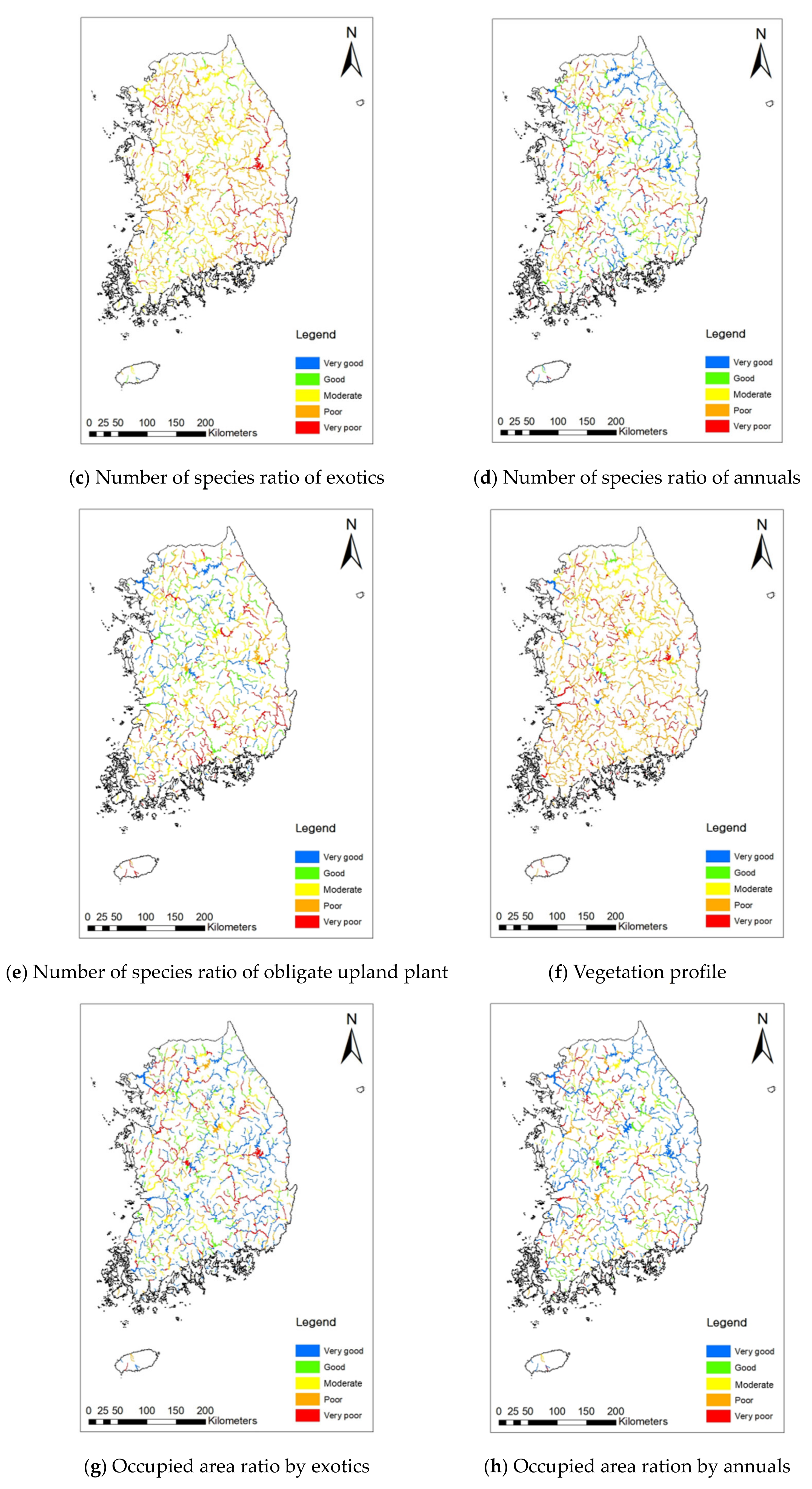
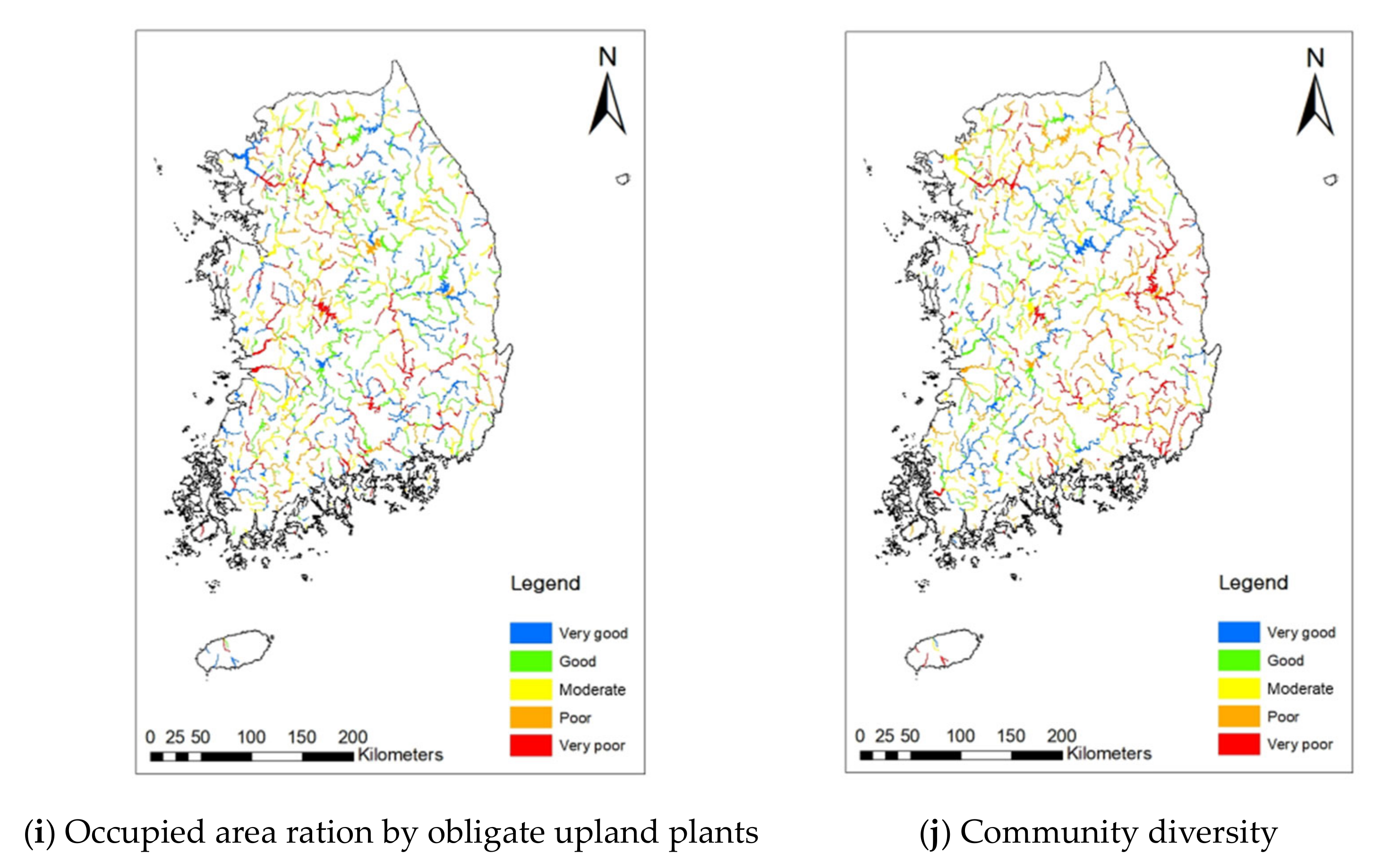
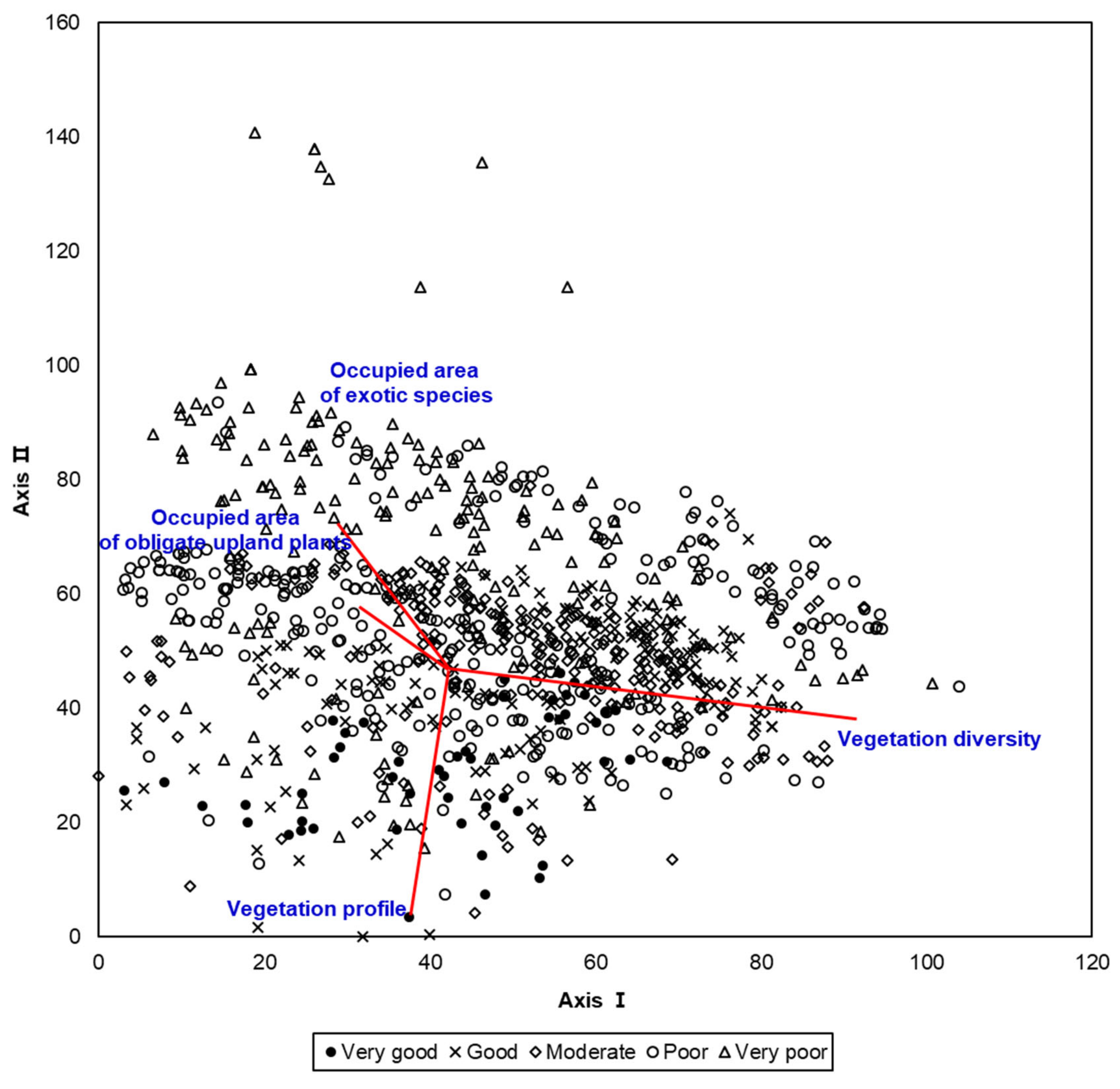
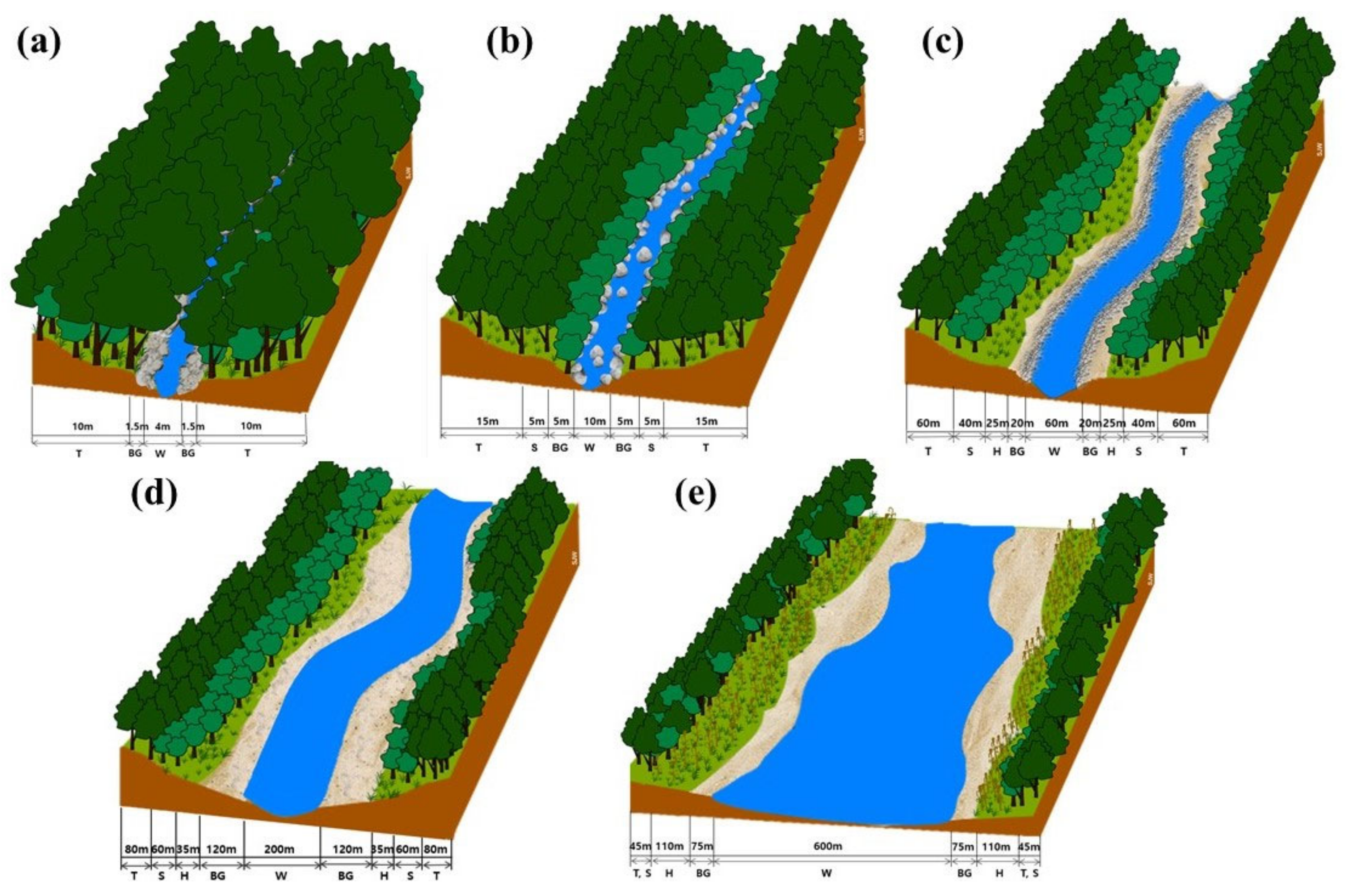
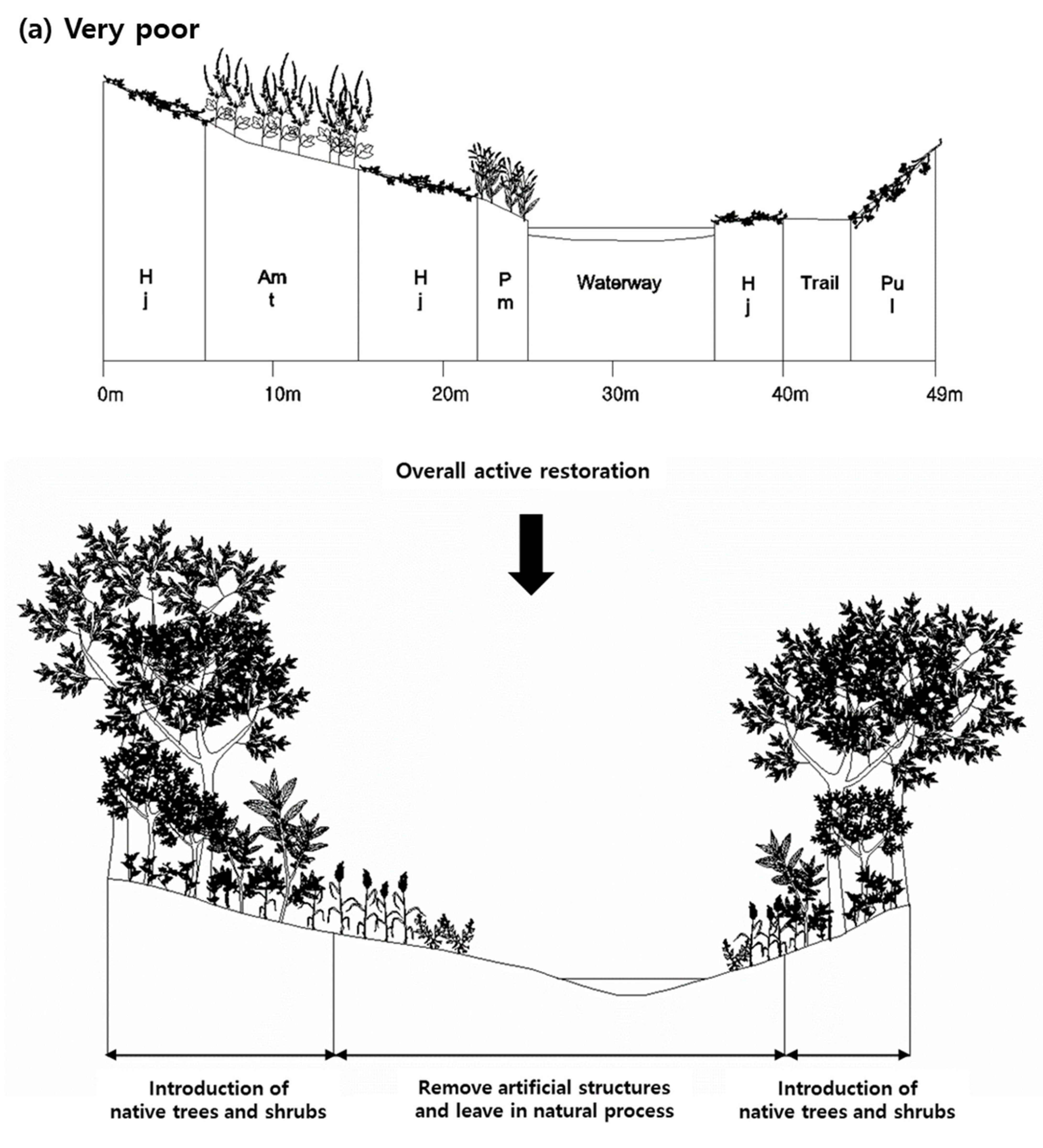
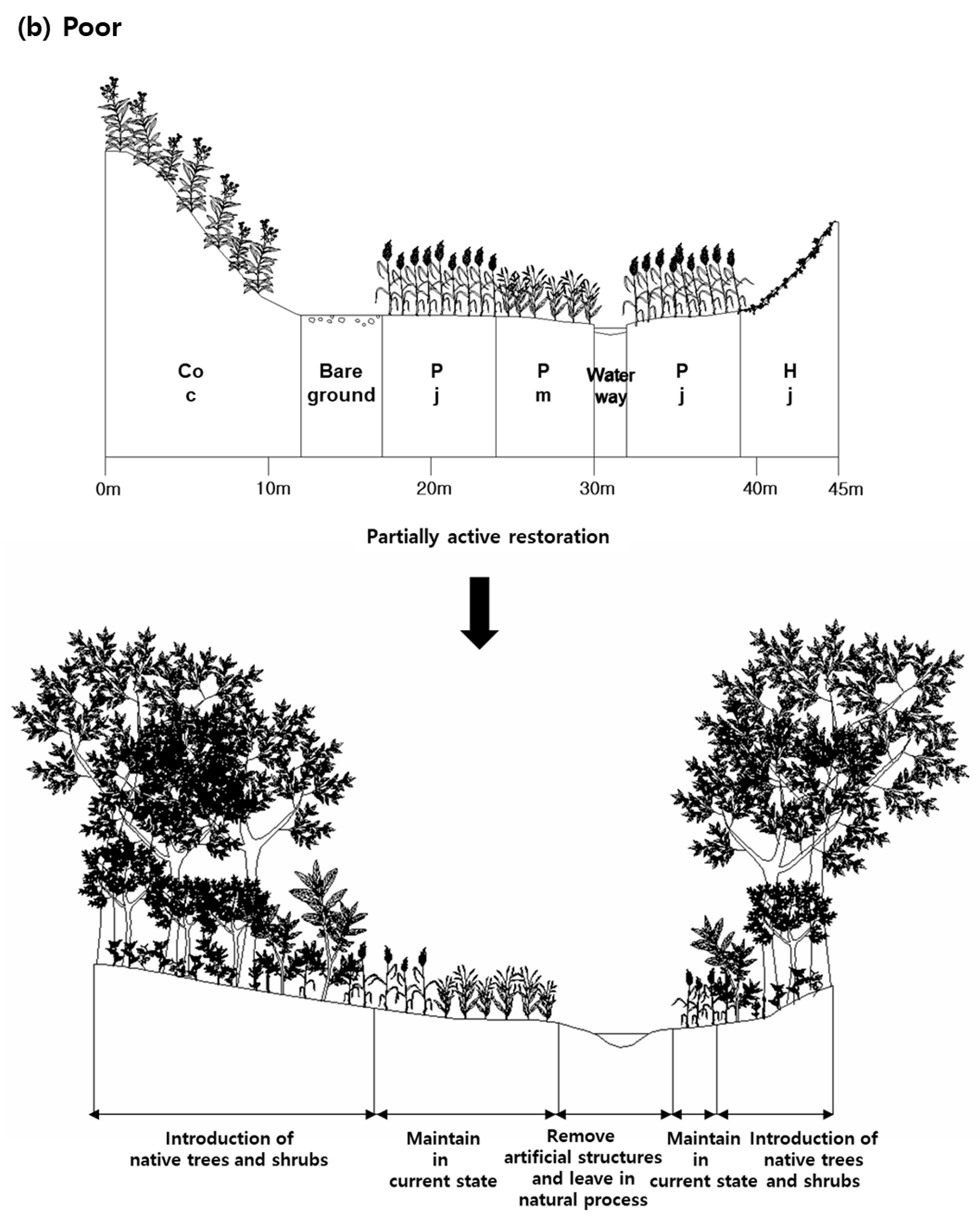


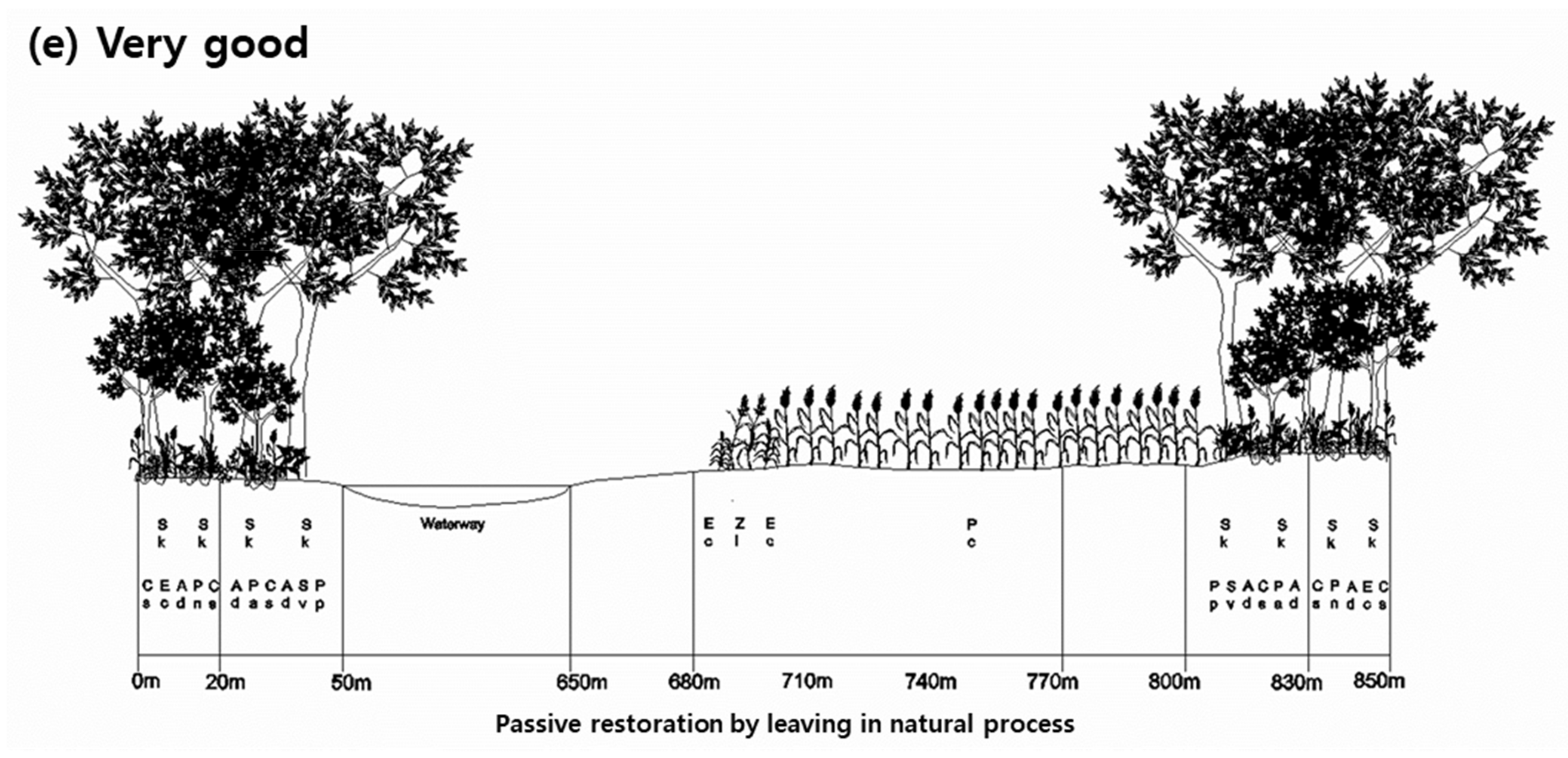
| Score Component | 1 | 2 | 3 | 4 | 5 |
|---|---|---|---|---|---|
| Community diversity (no. of communities, 4) | <3 | 4 to 5 | 6 to 7 | 8 to 9 | >10 |
| No. of exotic species (%, 1) | >34 | 25 to 34 | 15 to 24 | 5 to 14 | <5 |
| No. of annual plants (%, 1) | <9, >56 | 51 to 55 | 46 to 50 | 41 to 45 | 10 to 40 |
| No. of obligate upland plant (%, 1) | >75 | 71 to 75 | 66 to 70 | 61 to 65 | <61 |
| Occupied area by exotic plants (%, 1) | >35 | 26 to 35 | 16 to 25 | 6 to 15 | <6 |
| Occupied area by annual plants (%, 1) | >49 | 37 to 49 | 24 to 36 | 11 to 23 | <11 |
| Occupied area by obligate upland plants (%, 1) | >71 | 55 to 71 | 38 to 54 | 21 to 37 | <21 |
| Vegetation profile (grade, 8) 1 | First | Second | Third | Fourth | Fifth |
| Species diversity (no. of species, 2) | <31 | 31 to 40 | 41 to 50 | 51 to 60 | >60 |
| Grade of Naturalness | Very Good | Good | Moderate | Poor | Very Poor |
|---|---|---|---|---|---|
| Score range | >70 | 61 to 70 | 51 to 60 | 41 to 50 | <41 |
| Species Diversity | Community Diversity | Vegetation Profile | No. of Exotic Plants | No. of Obligate Upland Plants | No. of Annual Plants | Occupied Area of Exotic Species | Occupied Area of Obligate Upland Plants | Occupied Area of Annual Plants | |
|---|---|---|---|---|---|---|---|---|---|
| Community diversity | 0.17 ** | ||||||||
| Vegetation profile | 0.35 ** | 0.11 ** | |||||||
| No. of exotic species | −0.03 | −0.02 | −0.08 * | ||||||
| No. of obligate upland plants | 0.00 | −0.12 ** | −0.10 ** | 0.08 * | |||||
| No. of annual plants | −0.07 * | 0.09 ** | −0.23 ** | 0.32 ** | −0.29 ** | ||||
| Occupied area of exotic species | 0.09 ** | 0.16 ** | 0.02 | 0.29 ** | 0.09 ** | 0.03 | |||
| Occupied area of obligate upland plants | 0.00 | 0.12 ** | −0.14 ** | 021 ** | 0.14 ** | 0.08 * | 0.44 ** | ||
| Occupied area of annual plants | −0.04 | 0.04 | −0.23 ** | 0.17 ** | −0.07 * | 0.37 ** | 0.11 ** | 0.34 ** | |
| Riparian vegetation index | 0.52 ** | 0.51 ** | 0.76 ** | −0.25 ** | −0.16 ** | −0.26 ** | −0.11 ** | −0.29 ** | −0.35 ** |
| Environmental Factors | BMI | TDI | FAI | HRI | BOD |
|---|---|---|---|---|---|
| RVI | 0.18 ** | 0.26 ** | 0.19 ** | 0.16 ** | −0.10 ** |
| Geographic Segment | Vegetation Zone | Vegetation Layer | ||
|---|---|---|---|---|
| Canopy and Understory Tree | Shrub | Herb | ||
| Upper Valley | Tree zone | Acer pictum subsp. mono, Carpinus cordata, Cornus controversa, Fraxinus mandshurica, Fraxinus rhynchophylla, Juglans mandshurica, Magnolia sieboldii etc. | Celastrus flagellaris, Deutzia parviflora, Lindera obtusiloba, Staphylea bumalda, Stephanandra incisa etc. | Astilbe rubra, Carex lanceolata, Chrysosplenium grayanum, Corydalis speciosa, Dryopteris crassirhizoma, Festuca ovina, Geum japonicum, Impatiens noli-tangere, Lamium album var. barbatum, Ligularia fischeri, Thalictrum aquilegifolium var. sibiricum, Vicia amoena etc. |
| Lower Valley | Tree zone | Acer pictum subsp. mono, Acer tataricum subsp. ginnala, Carpinus cordata, Fraxinus mandshurica, Fraxinus rhynchophylla, Juglans mandshurica, Salix koreensis, Ulmus davidiana var. japonica etc. | Alangium platanifolium var. trilobum, Flueggea suffruticosa, Salix gracilistyla, Staphylea bumalda, Stephanandra incisa, Weigela subsessilis etc. | Boehmeria tricuspis, Corydalis speciosa, Dryopteris crassirhizoma, Impatiens textori, Persicaria longiseta, Persicaria thunbergii, Prunella vulgaris var. lilacina, Pteridium aquilinum var. latiusculum, Stellaria alsine var. undulata, Vicia unijuga etc. |
| Upstream | Tree zone | Acer tataricum subsp. ginnala, Fraxinus rhynchophylla, Juglans mandshurica, Salix chaenomeloides, Salix koreensis, Salix subfragilis, Ulmus davidiana var. japonica etc. | Salix gracilistyla, Salix integra etc. | Artemisia selengensis, Carex glabrescens, Miscanthus sacchariflorus, Oenanthe javanica, Persicaria hydropiper, Persicaria thunbergii, Phalaris arundinacea, Phragmites japonica, Scirpus radicans, Stellaria aquatica etc. |
| Shrub zone | - | Rosa multiflora, Philadelphus schrenkii, Salix graciliglans, Salix gracilistyla, Salix integra, Staphylea bumalda etc. | Artemisia capillaris, Equisetum arvense, Miscanthus sacchariflorus, Oenanthe javanica, Persicaria thunbergii, Phalaris arundinacea, Phragmites communis, Phragmites japonica, Scirpus radicans etc. | |
| Herb zone | - | - | Artemisia selengensis, Barbarea orthoceras, Cardamine flexuosa, Carex neurocarpa, Corydalis speciosa, Impatiens noli-tangere, Impatiens textori, Miscanthus sacchariflorus, Oenanthe javanica, Persicaria nodosa, Persicaria thunbergii, Phalaris arundinacea, Phragmites japonica, Scirpus radicans, Viola verecunda etc. | |
| Midstream | Tree zone | Morus alba, Salix chaenomeloides, Salix koreensis, Salix pseudolasiogyne, Salix subfragilis, Ulmus parvifolia, Salix chaenomeloides etc. | Salix gracilistyla, Salix integra, Salix koriyanagi, Rosa multiflora etc. | Artemisia selengensis, Carex glabrescens, Carex miyabei, Centella asiatica, Impatiens noli-tangere, Miscanthus sacchariflorus, Oenanthe javanica, Phalaris arundinacea, Phragmites communis, Phragmites japonica, Scirpus radicans etc. |
| Shrub zone | - | Salix graciliglans, Salix gracilistyla, Salix integra etc. | Alopecurus aequalis, Carex glabrescens, Equisetum arvense, Miscanthus sacchariflorus, Persicaria thunbergii, Phalaris arundinacea, Phragmites communis, Phragmites japonica, Scirpus radicans, Stellaria aquatica, Typha orientalis etc. | |
| Herb zone | - | - | Artemisia selengensis, Centella asiatica, Echinochloa crusgalli var. oryzicola, Lespedeza cuneata, Miscanthus sacchariflorus, Penthorum chinense, Persicaria hydropiper, Persicaria nodosa, Phalaris arundinacea, Phalaris japonica, Phragmites communis, Phragmites japonica, Sium suave etc. | |
| Downstream | Tree zone | Salix chaenomeloides, Salix koreensis, Salix pseudolasiogyne, Salix subfragilis etc. | Rosa multiflora, Salix gracilistyla, Salix koriyanagi, Salix integra etc. | Artemisia selengensis, Miscanthus sacchariflorus, Oenanthe javanica, Persicaria dissitiflora, Persicaria thunbergii, Phalaris arundinacea, Phragmites communis, Phragmites japonica, Scirpus radicans, Typha orientalis etc. |
| Herb zone | - | - | Artemisia selengensis, Carex glabrescens, Carex scabrifolia, Cyperus amuricus, Echinochloa crusgalli var. echinata, Echinochloa utilis, Eclipta prostrata, Juncus effusus var. decipiens, Miscanthus sacchariflorus, Persicaria thunbergii, Phacelurus latifolius, Phalaris arundinacea, Phragmites communis, Phragmites japonica, Scirpus radicans, Viola verecunda, Zizania latifolia etc. | |
| Naturalness Degree | Degradation Degree | Restoration Level | Restoration Method |
|---|---|---|---|
| Very poor | Very severely degraded | Overall active restoration | Restoration throughout the entire range of the riparian landscape from the channel through the floodplain to the weir, including morphology of river, vegetation, watershed management, and networking with the surrounding terrestrial ecosystem. |
| Poor | Severely degraded | Partially active restoration | Similar restoration to the above but at a lower level Transformation of waterfront protection material from artificial to natural ones and introduction of vegetation on the floodplain and levee |
| Moderate | Moderately degraded | Combination of active and passive restoration | Transformation of waterfront protection material from artificial to natural ones and introduction of vegetation on some parts of the floodplain and the levee |
| Good | Lightly degraded | Artificial support | Transformation of waterfront protection material from artificial to natural ones and induction of establishment of natural vegetation on the levee |
| Very good | Natural | Passive restoration | Leave in its natural process |
Publisher’s Note: MDPI stays neutral with regard to jurisdictional claims in published maps and institutional affiliations. |
© 2021 by the authors. Licensee MDPI, Basel, Switzerland. This article is an open access article distributed under the terms and conditions of the Creative Commons Attribution (CC BY) license (http://creativecommons.org/licenses/by/4.0/).
Share and Cite
Lim, C.H.; Pi, J.H.; Kim, A.R.; Cho, H.J.; Lee, K.S.; You, Y.H.; Lee, K.H.; Kim, K.D.; Moon, J.S.; Lee, C.S. Diagnostic Evaluation and Preparation of the Reference Information for River Restoration in South Korea. Int. J. Environ. Res. Public Health 2021, 18, 1724. https://doi.org/10.3390/ijerph18041724
Lim CH, Pi JH, Kim AR, Cho HJ, Lee KS, You YH, Lee KH, Kim KD, Moon JS, Lee CS. Diagnostic Evaluation and Preparation of the Reference Information for River Restoration in South Korea. International Journal of Environmental Research and Public Health. 2021; 18(4):1724. https://doi.org/10.3390/ijerph18041724
Chicago/Turabian StyleLim, Chi Hong, Jeong Hoon Pi, A Reum Kim, Hyun Je Cho, Kyu Song Lee, Young Han You, Kye Han Lee, Kee Dae Kim, Jeong Suk Moon, and Chang Seok Lee. 2021. "Diagnostic Evaluation and Preparation of the Reference Information for River Restoration in South Korea" International Journal of Environmental Research and Public Health 18, no. 4: 1724. https://doi.org/10.3390/ijerph18041724
APA StyleLim, C. H., Pi, J. H., Kim, A. R., Cho, H. J., Lee, K. S., You, Y. H., Lee, K. H., Kim, K. D., Moon, J. S., & Lee, C. S. (2021). Diagnostic Evaluation and Preparation of the Reference Information for River Restoration in South Korea. International Journal of Environmental Research and Public Health, 18(4), 1724. https://doi.org/10.3390/ijerph18041724






